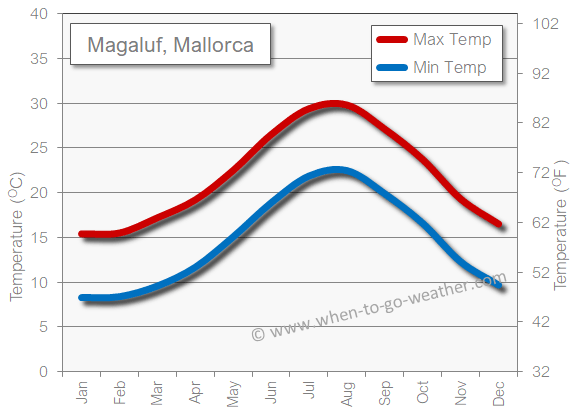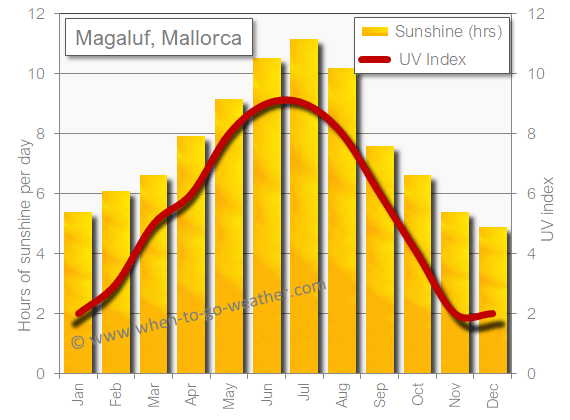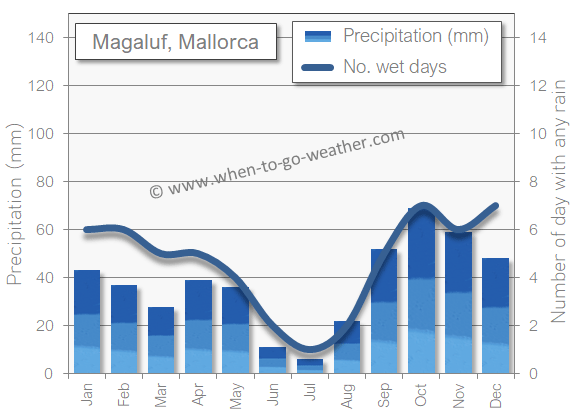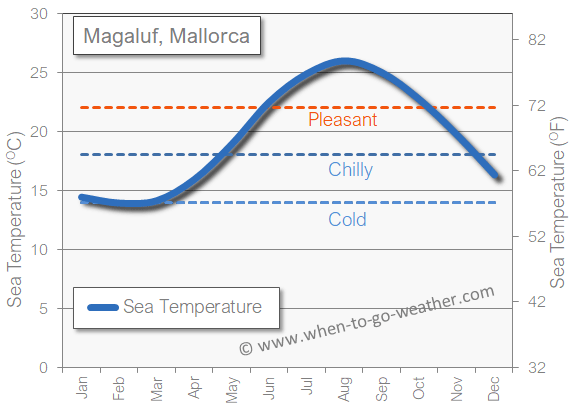Magaluf, Mallorca in March - The weather and is it a good time of year to visit?
A jewel of Spain's Balearic Islands, Magaluf is a tantalising coastal town on the island of Mallorca. Renowned for its vibrant nightlife and scenic sandy beaches, this Mediterranean paradise offers a unique blend of sun-soaked relaxation and cultural exploration, guaranteeing an unforgettable holiday for every kind of traveller.
Is March a good time to visit Magaluf? Absolutely! Whilst the peak summer season may be overly hot for some, March is a delightful sweet spot, offering milder temperatures and a calming ambiance, ideal for enjoying both outdoor pursuits and indoor delights.
The weather of Magaluf through the year
The Mediterranean climate of Magaluf is one of its key draws, boasting warm, dry summers and mild, wet winters. The seasonal variation is somewhat moderated by the sea, ensuring temperatures remain relatively pleasant throughout the year. During the height of summer, temperatures can soar to the upper 30s Celsius (over 100F), but winter seldom sees the mercury dip below 10C (50F).
This steady climatic pattern ensures Magaluf is attractive year-round, but there is a marked increase in tourist influx from late spring to early autumn when the weather is at its most inviting. For those who prefer a more serene holiday, the shoulder months, like March, offer a pleasant respite from both temperature extremes and bustling crowds.
Magaluf's weather in March
In March, the Magaluf climate begins its transition from winter coolness to spring warmth. The average daytime maximum temperature during this month hovers around a pleasant 17C (63F), whilst at night, the mercury drops to a cooler but comfortable 8C (46F). These temperatures may not inspire a beach bonanza but are perfect for a variety of outdoor activities like hiking, sightseeing, and golf, as well as offering cosy evenings in local eateries and bars.

As the calendar shifts towards spring, daylight hours begin to increase in Magaluf. March sees daylight stretching approximately 12 hours a day, with sunrise around 7:00 am and sunset close to 7:00 pm, towards the end of the month. This prolonged daylight period affords ample opportunity to explore Magaluf and its surroundings in natural light.
The sun, however, isn't relentlessly beating down in March. Expect an average of six hours of sunshine daily, a modest increase from the winter months, but fewer than the summer's average of ten. While days can still be partly cloudy, it's typically the perfect blend of sunshine and cool breezes that make sightseeing, hiking, or enjoying a leisurely café visit both comfortable and enjoyable.

In March, rainfall is still present, though significantly less than the winter months. On average, Magaluf sees around 40mm of rain over six days in March. Heavy showers are infrequent, and when rain does fall, it is often short-lived, ensuring any outdoor plans need not be wholly abandoned.
Humidity levels remain relatively low in March, generally between 60-70%, which makes the weather feel pleasantly cool rather than uncomfortably chilly. These conditions contribute to the appeal of March as a holiday month, presenting the perfect equilibrium between warmth and moisture for comfortable exploration.

Despite the endearing land temperatures in March, the Mediterranean Sea surrounding Magaluf can still be relatively cool, with average sea temperatures around 14C (57F). These temperatures may not be enticing for a full dip unless you're particularly hardy, but they're certainly adequate for a quick paddle or waterside walk.

March falls within what is often termed the 'shoulder season' in Magaluf - the time between the peak and off-peak seasons. During this month, the town is beginning to shake off its winter quietude and gear up for the summer rush. Despite the slight increase in tourist numbers, compared to winter, it remains much less crowded than in the bustling summer months.
Accompanying this more subdued atmosphere are some financial advantages. Flights and accommodation are typically less expensive in March compared to the high season, making it an attractive time for budget-conscious travellers seeking a Mediterranean getaway.
As for the nightlife, it is relatively calmer, with many establishments beginning to extend their opening hours as the summer season approaches. However, the vibrant, energetic scenes that Magaluf is famous for are more prevalent in the summer months.
Hotel rooms and holiday rentals are unlikely to be sold out in March, presenting an ideal opportunity to secure a deal. From luxury resorts to quaint bed and breakfasts, options abound for every kind of traveller. March is a particularly good time for families with young children to visit, given the quieter streets and less crowded attractions, allowing for a more relaxed holiday experience.
The average age of tourists during this period tends to be a little higher, with fewer young party-goers and more families and middle-aged couples. At this time of year, most visitors hail from the UK and Northern Europe, looking to escape the last dregs of winter in their home countries.
Clothes to pack for March in Magaluf
When packing for a holiday in Magaluf in March, consider the mild weather and slightly cooler evenings. Comfortable walking shoes are a must for exploring the town and surrounding areas. Layered clothing would be ideal to adjust to the changing temperatures throughout the day, including light sweaters or cardigans. For the daytime, T-shirts and lightweight trousers will usually suffice.
As evenings can be a bit cooler, a light jacket is advisable, especially for waterfront or open-air dining experiences. A versatile wardrobe that allows for various activities, from beach visits to restaurant dining, will serve you well. Don't forget your swimsuit - even if the sea is too cold, many hotels have heated pools. An umbrella or waterproof jacket could also be useful given the chance of rain in March.
The best months to visit Magaluf
The best time to visit Magaluf really depends on your holiday preferences. For those seeking a vibrant party scene and bustling beaches, the summer months of June to August offer exactly that, along with balmy temperatures averaging 30C (86F) and up to 11 hours of sunshine per day. The shoulder months of April to June and September to October, however, provide a more laid-back atmosphere, pleasant temperatures, and fewer crowds, making them ideal for leisurely exploration and family vacations.
The worst months to visit Magaluf
If you're not a fan of sweltering heat, crowded beaches, and a frenetic nightlife, the peak summer months of July and August may not be the best time to visit Magaluf. This period sees a surge in tourist numbers, resulting in crowded attractions and higher prices. Moreover, the strong summer heat, with temperatures often rising above 30C (86F), may not be conducive to extended outdoor exploration for everyone. The same holds for winter months (December-February) if your aim is a classic beach holiday, as temperatures can dip, and many attractions and establishments operate on reduced hours or close for the season.
Fantastic activities for Magaluf during March
1. Visit the Palma de Mallorca: A day trip to the capital city of the Balearic Islands, Palma de Mallorca, is a must when visiting Magaluf in March. With its majestic Gothic cathedral, historic Bellver Castle, and bustling markets, Palma de Mallorca is a treasure trove of cultural delights. The pleasant March weather makes it an ideal time to stroll along its picturesque cobbled streets, enjoying its unique blend of Spanish and Moorish architecture, without the usual summer crowds.
2. Western Water Park: This family-friendly water park reopens in March after its winter closure, offering a plethora of thrilling water slides and a wave pool for all ages. As March is not the peak season, you will have more chances to enjoy the attractions without having to wait in long queues. For the less adventurous, there are ample sunbathing areas and eateries, making it a full day of fun for the whole family.
3. Boat Excursions: Make the most of the island's coastal location by embarking on a boat tour. Numerous companies offer a variety of excursions, from peaceful sunset cruises to adventurous dolphin watching trips. Even though the sea temperatures in March might not be ideal for swimming, the boat rides still provide an excellent opportunity to marvel at Mallorca's stunning coastline and crystal-clear waters.
4. Hiking in Serra de Tramuntana: For nature enthusiasts, a hike in the Serra de Tramuntana, a UNESCO World Heritage site, is a must. The cooler March temperatures make it a perfect time for a leisurely trek through this breathtaking mountain range. There are numerous trails of varying difficulty levels, all offering panoramic views of the Mediterranean and the surrounding countryside.
5. Explore Local Cuisine: Take the time to savour the flavours of Magaluf and wider Mallorca during your stay. From delectable tapas bars to high-end seafood restaurants, there's a wide range of culinary experiences to explore. Many local establishments offer wine-tasting sessions, featuring local wines that pair perfectly with the region's cuisine. March, being outside the peak season, is an excellent time to secure reservations at some of the island's most sought-after eateries.
6. Visit the House of Katmandu: This unique theme park, shaped like an upside-down mansion, is one of Magaluf's top attractions. It offers an intriguing mix of high-tech interactive games, a 4D cinema, and even a mini-golf course. A visit to the House of Katmandu is a great option for both families and solo travellers, providing a unique entertainment experience unlike any other.
7. Beach Time at Platja de Magaluf: While the sea might be too cold for swimming in March, the beach itself is still a delightful place to relax and soak up the tranquil atmosphere. You can walk along the broad stretch of golden sand, engage in beach games, or simply sit back and enjoy the stunning views of the turquoise Mediterranean. Additionally, beachside cafes and restaurants remain open, providing the perfect backdrop for a relaxed lunch or a romantic dinner.